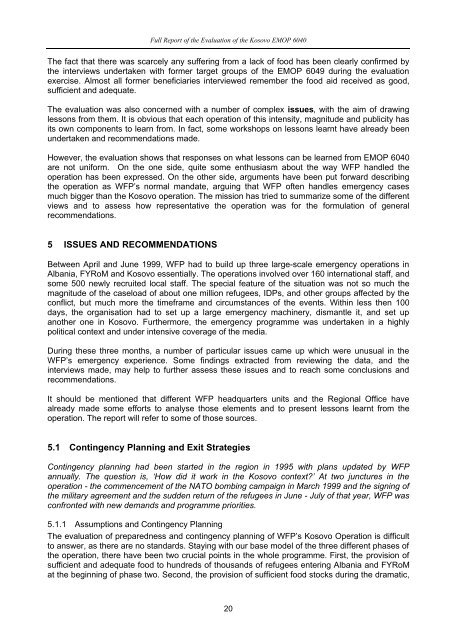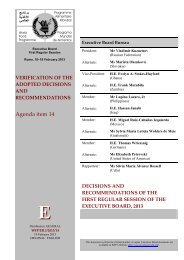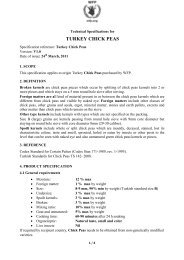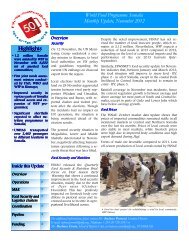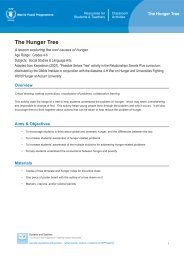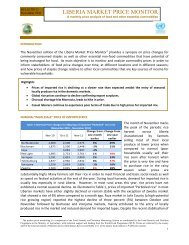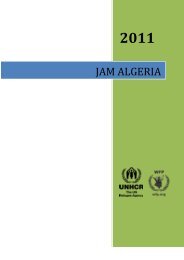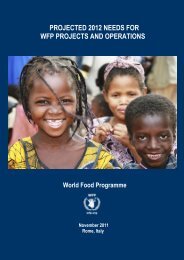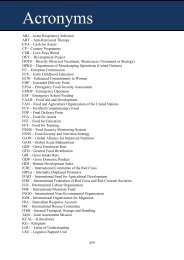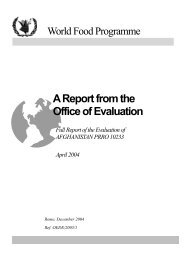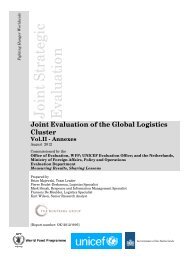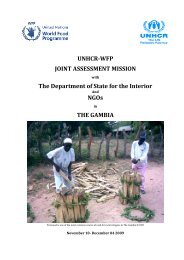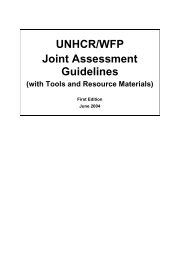Full Report - WFP Remote Access Secure Services
Full Report - WFP Remote Access Secure Services
Full Report - WFP Remote Access Secure Services
You also want an ePaper? Increase the reach of your titles
YUMPU automatically turns print PDFs into web optimized ePapers that Google loves.
<strong>Full</strong> <strong>Report</strong> of the Evaluation of the Kosovo EMOP 6040<br />
The fact that there was scarcely any suffering from a lack of food has been clearly confirmed by<br />
the interviews undertaken with former target groups of the EMOP 6049 during the evaluation<br />
exercise. Almost all former beneficiaries interviewed remember the food aid received as good,<br />
sufficient and adequate.<br />
The evaluation was also concerned with a number of complex issues, with the aim of drawing<br />
lessons from them. It is obvious that each operation of this intensity, magnitude and publicity has<br />
its own components to learn from. In fact, some workshops on lessons learnt have already been<br />
undertaken and recommendations made.<br />
However, the evaluation shows that responses on what lessons can be learned from EMOP 6040<br />
are not uniform. On the one side, quite some enthusiasm about the way <strong>WFP</strong> handled the<br />
operation has been expressed. On the other side, arguments have been put forward describing<br />
the operation as <strong>WFP</strong>’s normal mandate, arguing that <strong>WFP</strong> often handles emergency cases<br />
much bigger than the Kosovo operation. The mission has tried to summarize some of the different<br />
views and to assess how representative the operation was for the formulation of general<br />
recommendations.<br />
5 ISSUES AND RECOMMENDATIONS<br />
Between April and June 1999, <strong>WFP</strong> had to build up three large-scale emergency operations in<br />
Albania, FYRoM and Kosovo essentially. The operations involved over 160 international staff, and<br />
some 500 newly recruited local staff. The special feature of the situation was not so much the<br />
magnitude of the caseload of about one million refugees, IDPs, and other groups affected by the<br />
conflict, but much more the timeframe and circumstances of the events. Within less then 100<br />
days, the organisation had to set up a large emergency machinery, dismantle it, and set up<br />
another one in Kosovo. Furthermore, the emergency programme was undertaken in a highly<br />
political context and under intensive coverage of the media.<br />
During these three months, a number of particular issues came up which were unusual in the<br />
<strong>WFP</strong>’s emergency experience. Some findings extracted from reviewing the data, and the<br />
interviews made, may help to further assess these issues and to reach some conclusions and<br />
recommendations.<br />
It should be mentioned that different <strong>WFP</strong> headquarters units and the Regional Office have<br />
already made some efforts to analyse those elements and to present lessons learnt from the<br />
operation. The report will refer to some of those sources.<br />
5.1 Contingency Planning and Exit Strategies<br />
Contingency planning had been started in the region in 1995 with plans updated by <strong>WFP</strong><br />
annually. The question is, ‘How did it work in the Kosovo context?’ At two junctures in the<br />
operation - the commencement of the NATO bombing campaign in March 1999 and the signing of<br />
the military agreement and the sudden return of the refugees in June - July of that year, <strong>WFP</strong> was<br />
confronted with new demands and programme priorities.<br />
5.1.1 Assumptions and Contingency Planning<br />
The evaluation of preparedness and contingency planning of <strong>WFP</strong>’s Kosovo Operation is difficult<br />
to answer, as there are no standards. Staying with our base model of the three different phases of<br />
the operation, there have been two crucial points in the whole programme. First, the provision of<br />
sufficient and adequate food to hundreds of thousands of refugees entering Albania and FYRoM<br />
at the beginning of phase two. Second, the provision of sufficient food stocks during the dramatic,<br />
20


